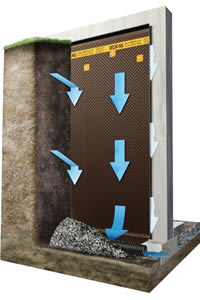| the process of waterproofing
What is involved in the Waterproofing Process?
If you choose The Waterproofer to waterproof the exterior of your basement, you will get the most professional job possible. To begin with, we take digital infrared photographs of the inside of your basement, so we can determine precisely the areas that are damp and require waterproofing (this is done at no charge to you during your free, no-obligation in-home consultation). Then we take a series of photographs of the areas of the exterior of your home where we will be digging, to plan with our team how best to approach the dig to minimize disruption to your home and gardens. If you have any special plants or bushes that are in the dig site we can, at your request, provide special planting bins for you to temporarily house the plants while the waterproofing work is taking place.
We then excavate a trench next to your home. The trench will be approximately two and a half feet wide, and between four and seven feet deep, depending on the depth of your basement footings. This exposes the foundation of your house, which we then thoroughly clean by hand, using scrapers and brushes, so that we can locate all cracks and holes that may be letting water into your basement. We then fill all cracks and holes with a special kind of cement called hydraulic cement. Hydraulic cement will bind and harden even when exposed to water, and expands to fill holes and cracks.
Next , we removed the old weeping tile around the area to be waterproofed. Later in the process, we will install brand new weeping tile and filter cloth.
 Even though we have filled the cracks and holes with hydraulic cement to keep water out of your basement, we next apply a liquid waterproof membrane to the exterior foundation. The membrane is flexible and will bridge any cracks that appear in your foundation in the future. Over the waterproof membrane we place DELTA®-MS board, which is a dimpled membrane, impermeable to water and water vapour. Although this product is a bit more expensive that other similar products, we believe it is the best product currently on the market for ensuing that no water penetrates your basement, even in the (unlikely) event that both the hydraulic cement and liquid waterproof membrane fail. The unique design of the MS-Delta™ board creates an air-gap between the membrane and the foundation wall, which allows any incidental water getting past the dimpled membrane to flow freely to the perimeter footing drain. The air-gap created by the exclusive dimple pattern guarantees a safe separation and full capillary break between the foundation wall and any ground moisture. Even though we have filled the cracks and holes with hydraulic cement to keep water out of your basement, we next apply a liquid waterproof membrane to the exterior foundation. The membrane is flexible and will bridge any cracks that appear in your foundation in the future. Over the waterproof membrane we place DELTA®-MS board, which is a dimpled membrane, impermeable to water and water vapour. Although this product is a bit more expensive that other similar products, we believe it is the best product currently on the market for ensuing that no water penetrates your basement, even in the (unlikely) event that both the hydraulic cement and liquid waterproof membrane fail. The unique design of the MS-Delta™ board creates an air-gap between the membrane and the foundation wall, which allows any incidental water getting past the dimpled membrane to flow freely to the perimeter footing drain. The air-gap created by the exclusive dimple pattern guarantees a safe separation and full capillary break between the foundation wall and any ground moisture.
Next, new weeping tile is laid at the base of the foundation of your home. Weeping tile is a 4" pipe with small perforations to allow water to penetrate the pipe and be carried away. The weeping tile is covered with a filter cloth that stops silt and soil from infiltrating the pipe over time. We cover the weeping tile with a layer of clear (and clean) limestone to minimize the dirt that may find its way to the filter cloth.
Finally, the excavation is refilled with the material that was removed in the first step. The fill is compacted every 12" to prevent settling around the house.
The work is complete, and you have the peace of mind of knowing that you don’t have to worry about water damage to your foundation or the structure of your home, or about the health concerns that can be associated with a damp basement. Plus, you have a fully transferrable 25 year warranty to count on!
Here is a link to an article by Mike Holmes on weeping tile. Click here
 |
MS Delta Board
is applied over
the applied membrane. |
interested in learning more?
health concerns
- Excess moisture can cause mold, fungus or mildew to grow
- Certain molds can be harmful to your health
- Not all molds are dangerous
- Mold need four components to grow; oxygen, mold spores, organic material and water
Find Out More > |
|
blog
Read the Latest > |
|

